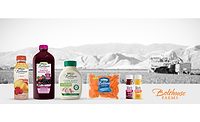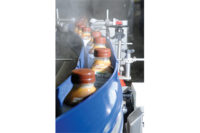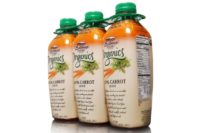“Fresh” can be a relative term to people as they describe what it means to them. For Bolthouse Farms, Bakersfield, Calif., and Camden, N.J.-based Campbell Soup Co., the concept of “packaged fresh” became linked when Campbell Soup Co. acquired Bolthouse for approximately $1.55 billion earlier this year.
“We feel great. As a private-equity-backed company, we always knew that at some point we would sell the company to a new owner, and our hope was whoever the new owner was really bought into our vision for the company and could provide the right kind of platform for us to accelerate what we’re doing, and that’s exactly what we found with Campbell’s; we’ve got a great owner,” says Jeff Dunn, president and chief executive officer of Bolthouse. “They totally believe in what we’re doing and … they’ve given us the support to not only keep doing it, but to accelerate.”
That acceleration includes a commitment to innovation within Bolthouse’s respective units: salad dressings, carrots and super-premium juices and smoothies.
“The language that Campbell’s has used is ‘packaged fresh,’ which simply means that the consumer is really looking for fresh versions of all the kinds of product categories they’re used to in the center of the store, whether that’s soup or sauces or juices,” Dunn says. “At some level, there’s still a huge opportunity to innovate around fresh versions of center-of-store categories, and that’s basically what we’ve done with beverages is created a whole new category by making fruits and vegetables more accessible to people through beverages.
“I’d say that’s really where our focus is — how do we make this ‘packaged fresh’ idea more robust and give people healthier options, because for us it’s pretty easy calculus,” he continues. “’Fresh’ doesn’t always equal healthy, but ‘fresh’ is going to be much more aligned with healthy products — especially fruit- and vegetable-based products — so we really view ‘packaged fresh’ as a way to provide healthier options to people. It really comes down to marketing and innovation — product innovation, packaging innovation — the same things that have driven beverages forever, I think, are applicable to each one of these other kinds of categories.”
Structured as a separate business unit, Dunn notes that Bolthouse really has the best of both worlds with its position within Campbell’s, where it can still operate independently but also benefit from the resources that Campbell’s can offer, such as shopper and consumer insights as well as data banks.
Although a few things have changed admin-istratively, for the consumer nothing has changed, he adds.
“The things that have remained the same are really the vision and the mission and the strategy and our approach,” Dunn says. “None of those things has changed. In fact, what Campbell’s has said to us is, ‘We don’t want to change anything. We bought you because we really buy into that vision for the company.’”
Part of that vision can tie into the company’s corporate social responsibility commitment, which includes providing more opportunities for consumers to eat more fruits and vegetables and to administer more sustainable practices.
“As a primary mission for the company, we call it inspiring ‘the fresh revolution,’ and this is about partnering with consumers on their journey to health by providing healthy, innovative products, whether those are beverage or food products,” Dunn explains.
He adds that for Bolthouse it is important that the products they offer are good for consumers, but how they manufacture those products is just as important.
“We’re constantly looking to drive more sustainable practice and food system needs,” Dunn says. “… As farmers, we’ve always had that relationship to the land; we understand you can’t over-farm land or you’re not going to have a productive asset over time, so a lot of the way we come in for corporate social responsibility in the sustainability area is all about how we treat the land [and] how we partner with our growers and suppliers to ensure that as we’re providing the ingredients to our product, whether it’s carrots or others, that all of those are grown, processed and delivered in the most sustainable fashion possible.”
Some farming examples include the company installing solar panels to power its engine that pumps the water up to water its carrots in Lancaster, Calif., as well as transporting its beverages, which are manufactured in its Bakersfield facility, via train to its distribution centers in Chicago.
“From a food mile standpoint, it’s much more efficient to put it on that train, and that train goes every single day, so we’re constantly looking at food miles,” he says. “We’re looking at sourcing and ultimately the land practices around the products that we use to ensure that they are really state-of-the-art in terms of sustainability practices.”
The company’s commitment to and knowledge about fresh, healthy foods and beverages is one that Dunn expresses admiration for and something that he considers to be an asset that Bolthouse can provide to its new parent company.
“I think we bring three big things to Campbell’s: one is this ‘fresh’ mindset,” he says. “Because we make fresh products, [they] tend to have a shorter shelf life — you’ve got to handle them in a different way — so that ‘fresh’ mindset operationally, from a marketing perspective, I think is really new for them. The second thing is called fast innovation. … Like many companies, everyone wants to innovate, but … because we’re smaller, we’ve got a very tight and fast approach to innovation.
“You know the category we’re in — the super-premium beverages — this is a category that new news is very important, so you actually have to constantly bring in innovation … so we bring that fast innovation cycle,” he continues. “The last thing we bring to Campbell’s is, I think, some real perspective and insight into health and what ingredients can mean to people.”
That insight comes from Bolthouse’s relationships that it has developed with nutritionists and universities to understand the effects that vitamins and minerals have on the body. For example, the company worked with the University of Texas to learn how the body absorbs different forms of protein. Dunn notes that the research — using a product that contained both soy and whey protein — found that the body absorbs soy and whey proteins at different rates. Using this proprietary research, Bolthouse was able to share this insight with Campbell’s, he adds.
Although Campbell’s already participates in the healthy beverage segment with its V-8 brand, the product lineup is shelf-stable, so operationally there are not any synergies to Bolthouse’s fresh products; however, Campbell’s expertise in tomato-based beverages could offer Bolthouse insight into that realm, Dunn adds. He highlights that sharing research and development (R&D) capabilities, insight and innovation capabilities as well as marketing will be a wonderful benefit of being a part of Campbell’s.
“I think the biggest thing is scale and consumer marketing capabilities,” Dunn notes. “As a small company, we had some research capabilities, insight capabilities, but with [Campbell’s], they have much more robust capabilities in that area. We are sharing in our R&D and innovation capabilities. For a company our size, we had a lot, but we can leverage off what they’re already doing, and ultimately it’s about providing consumers more interesting products, [and] all of the marketing infrastructure can help us accelerate what we’re doing.”
Sprouting innovation
Built earlier this year on its 1-square-mile facility in Bakersfield, Bolthouse invested $5 million in its innovation center. The facility addition houses the R&D team, lab, kitchen, consumer sensory facility as well as the marketing team.
“Here we can do anything a bigger company can do,” says Kamal Aboshamaa, vice president of R&D with Bolthouse. “The scale is different, but the results are just as good. We believe it is about the people that we have here that work here; it is about the environment … it is an innovative environment that gives us the ability to do the things that we want to do with the right tools. So our target is always to have the right people, the right environment [and] the right tools, and that gets us the innovation mindset that we’re looking for.”
Positioned at the entrance of the center, the company timeline depicts its major milestones, including its founding in 1915 and the launch of its super-premium juices in 2003. Since that launch nine years ago, the company has developed varieties based on consumer need states and occasions but found that the juice it produces based on its flagship product — carrots — has experienced phenomenal growth in the last few years, notes Todd Putman, chief marketing officer with Bolthouse.
“100% Carrot is one of the best performing flavors in our portfolio,” Putman says. “People who drink carrot juice tend to drink it regularly, as a part of their routine, so we see very high loyalty on that flavor, in particular.”
That increased demand for carrot juice helped fuel one of the company’s latest juice offerings: Orange + Carrot.
“The idea behind Orange + Carrot was to bring the benefits of carrot juice to a broadly appealing juice that people are used to,” Putman explains. “This gives people an easy way to get some veggies into their regular routine.”
Released this summer, Orange + Carrot contains 300 percent more vitamin A than traditional orange juice, the company says.
In addition to its juices, Bolthouse offers a range of other super-premium lineups such as its Protein Plus, Cafés, Smoothies and its latest lineup of Breakfast Smoothies.
“We’re looking at consumer need states and consumer occasions and where the white spaces are [and] where the empty spots are,” Putman says.
He adds that those need states are driven by the functionality of beverages. “If you think about how you would consume these drinks, there are very different places and ways,” Putman explains. “We talk about [how in] the morning you need protein, you need to get up and get going … if I’m really exercising and run a mile or whatever, I need hydration and potassium, so it really is about occasions and very functional qualities.”
Addressing consumer trends for breakfast, such as time, convenience and nutritional value, Bolthouse released its Breakfast Smoothies in Peach Parfait and Strawberry Parfait varieties, Putman notes. The smoothies include 10 grams of protein in each single-serve bottle along with 2.5 grams of fiber and 15 percent of the required daily value of calcium, the company says.
Also meeting consumer demands is the company’s Protein Plus line. “People are craving protein right now, either after a workout or even moms with kids — that’s a pretty tough day. So the notion of having an easy, affordable and healthy protein drink is amazing to be able to get all of that function, if you will, in a beverage drink,” Putman explains.
Available in Mango, Chocolate and its latest variety, Blended Coffee, the Protein Plus line contains 16 grams of protein in each 8-ounce serving and offers a combination of both soy and whey proteins.
Also understanding consumer need states for energy and an afternoon pick-me-up, Bolthouse’s Cafés line targets energy as well as health by featuring protein and calcium, Putman says. Available in Mocha Cappuccino, Hazelnut Latte, Vanilla Latte, Vanilla Chai Tea and its recent release, Green Tea Soy Latte, the lineup’s calorie content is higher than its juice and smoothie varieties but still comparable to popular coffeehouse drinks, Putman notes.
Bolthouse also addressed healthy indulgence last year with its holiday Nog product, which contains 60 percent fewer calories than traditional eggnog, it says. Due to its success last year, Bolthouse will release the seasonal variety again this year in an increased number of retailers compared with last year, Putman says.
But those need states don’t simply end with product development. The company applies that same innovative approach to its packaging.
“We think that, beyond the efficacy of the products themselves and the nutritional aspects, the thing we can do to stay on the innovation trend is constantly look at packaging options,” Dunn says. “Packaging historically, especially in the beverage business, has been a major driver in new business and new volume, and we’re constantly looking at it not only from the standpoint of recyclability and those things, but what kind of packages are going to best meet consumer needs. We launched a couple of years ago a large-size family package, a 52-ounce bottle, which really made our product much more affordable on a cost per ounce basis to people, and that’s driven tremendous growth in the category, because one of the biggest issues was affordability of these smoothie-like products, so that’s a good example of using packaging to drive expanded consumption.”
Although Bolthouse and the overall super-premium juice category continue to experience growth, Putman notes that only 16 percent of U.S. households have purchased super-premium juices. He adds that in food, drug and mass merchandise channels, Bolthouse is leading the category with approximately 37 percent market share in terms of dollar sales. Putman credits the brand’s penetration to its quality and price.
As an example, the carrots that are used in the making of its 100% Carrot juice are harvested 24 hours before they go into production, he explains.
Noting that competitors in the super-premium juice category also offer high-quality products, Bolthouse is able to capitalize on the fact that when grocery stores are picking up orders for its carrots, they also are able to couple that delivery with Bolthouse’s beverages, which can get product to stores faster to help protect nutritional value and reduce the amount of shrink, Putman states.
Connecting with consumers
Just as important as it is to understand the functionality of consumer need states and occasions, so are the ways of connecting with consumers for Bolthouse.
Putman notes that Dunn and many other employees at Bolthouse will joke, “Why does junk food get to have all the fun when it comes to marketing and promotions?” One way the company tries to connect consumers with the benefits of fruits and vegetables is through its packaging.
“You look in the company store, and the photography that we use is pretty different than what our competitors do,” Putman says. “Nobody has the same kind of feature of the products in a romantic, healthy-looking way.”
Referring to the front-of-pack as a billboard, Putman notes that it features imagery of fresh produce but also calls out the important nutritional information, such as protein or vitamin content. He adds that this front-of-pack information connects well with a group it refers to as “whole foodies” — those who consciously look at nutritional content — but does not deter other segments that purchase its products.
Another way Bolthouse looks to connect with its consumers is through a digital strategy. In October, the company launched a new website, which it is coupling with a new social media strategy where it will use the major social networking sites in a more aggressive way, Putman states.
But all of its initiatives revert back to the company’s mission: to inspire “the fresh revolution.”
“We call it, ‘mission driven, strategy led, culture inspired,’” Putman says. “So when you ask questions about sustainability, it’s actually hard in a way for us to parse those things out because our mission is to inspire ‘the fresh revolution,’ to partner with consumers, and inspire ‘the fresh revolution’ to move more and more of the population to healthy fruits and vegetables so that they can live more vibrant lives.” BI









